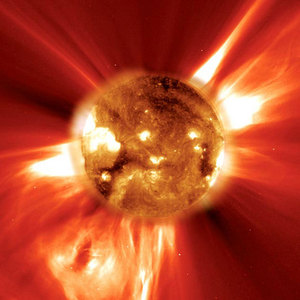
|
| ©SOHO, ESA, NASA |
Every 11 years or so, the sun gets a little pissy. It breaks out in a rash of planet-sized sunspots that spew superhot gas, hurling clouds of electrons, protons, and heavier ions toward Earth at nearly the speed of light. These solar windstorms have been known to knock out power grids and TV broadcasts, and our growing reliance on space-based technology makes us more vulnerable than ever to their effects. On January 3, scientists discovered a reverse-polarity sunspot, signaling the start of a new cycle - and some are predicting that at its peak (in about four years) things are gonna get nasty. Here's a forecast for 2012.
Detours
Clumps of ions in the atmosphere could interfere with GPS. Satellite signals are slowed by bumping into particles, meaning your trusty navigator may lose its way. Remember those colorful paper things called maps?
Falling Satellites
Increased solar energy heats Earth's atmosphere, causing it to expand. That's a drag on low-flying satellites and can even knock them out of orbit. A solar storm in 1979 deposited Skylab on Australia.
Layovers in Alaska
Particles are drawn to Earth's magnetic poles, right through popular flight paths. Electrons absorb the energy in shortwave signals, causing radio blackouts - and unscheduled stops in Anchorage.
Light Shows
Auroras occur when waves of charged particles light up gases in the upper atmosphere. As more particles stream in, the so-called aurora oval grows, bringing the "northern lights" as far south as Key West.



Reader Comments
What triggered this reverse-polarity sunspot? The coming Wave? Comets?